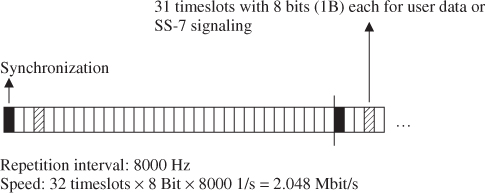1.3 Transmission Speeds
The smallest transmission speed unit in a classic circuit-switched telecommunication network is the digital signal level 0 (DS0) channel. It has a fixed transmission speed of 64 kbit/s. Such a channel can be used to transfer voice or data, and thus it is usually not called a speech channel but simply referred to as a user data channel.
The reference unit of a telecommunication network is an E-1 connection in Europe and a T-1 connection in the United States, which use either a twisted pair or coaxial copper cable. The gross datarate is 2.048 Mbit/s for an E-1 connection and 1.544 Mbit/s for a T-1. An E-1 is divided into 32 timeslots of 64 kbit/s each, as shown in Figure 1.3 while a T-1 is divided into 24 timeslots of 64 kbit/s each. One of the timeslots is used for synchronization, which means that 31 timeslots for an E-1 or 23 timeslots for a T-1, respectively, can be used to transfer data. In practice, only 29 or 30 timeslots are used for user data transmission while the rest (usually one or two) are used for SS-7 signaling data (see Figure 1.3). More about SS-7 can be found in Section 1.4.
Figure 1.3 Timeslot architecture of an E-1 connection.

A single E-1 connection with 31 DS0s is not enough to connect two switching centers with each other. An alternative is an E-3 connection over twisted pair or coaxial cables. An E-3 connection is defined at a speed ...
Get From GSM to LTE: An Introduction to Mobile Networks and Mobile Broadband now with the O’Reilly learning platform.
O’Reilly members experience books, live events, courses curated by job role, and more from O’Reilly and nearly 200 top publishers.

